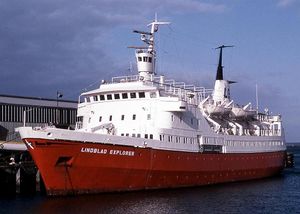Lindblad Explorer
Contents
History
December 1969. Delivered as the "Lindblad Explorer" to L.Usterud-Svensen.
1980 - 1982. Joint venture with Baoning Shipping/Baro Shipping with Klaveness and CNCo.
1985. Acquired by Discoverer Co. Renamed "Society Explorer".
1992. Renamed "Explorer".
November 23rd. 2007. Struck an iceberg and foundered off King George Island, South Shetlands.
Service
The introduction of side-port loaders into CNCo's Pacific trades in the 1960s was
an innovative but simple solution that was right for the time and place, while
Swire’s diversification into offshore oil support in the mid-1970s ultimately
developed into a core part of its marine portfolio. Other new ventures would
prove to be commercial dead-ends – although fun while they lasted.
One such was Lindblad Explorer, a 2,350-ton ice-class vessel, in which CNCo acquired a 50% stake in 1980. Built in 1969, Lindblad Explorer was the first custom-built vessel for the expeditionary cruise market. Carrying just 90 passengers, she cruised to the Antarctic Peninsula from Ushuaia or Punta Arenas via the Falkland Islands every southern summer and, during the remainder of the year, visited far flung destinations as then untouched by tourism, including Easter Island, the Galapagos, Alaska and the Amazon. It was a unique business and far removed from China Navigation’s cruise experience to date. Under the Swire flag, Lindblad Explorer became the first cruise ship to take American passengers into China since World War II, and undertook an 11,000-mile sub-Antarctic cruise from New Zealand to Argentina, as well as visiting the remoter islands in the Indonesian archipelago, the Barrier Reef, Papua New Guinea and the Red Sea. Passengers returned again and again but the adventure proved commercially disappointing and, at the end of two years, it was clear the operation was not a viable one for Swire long-term.




